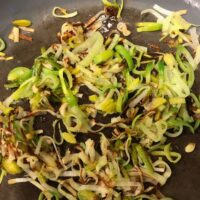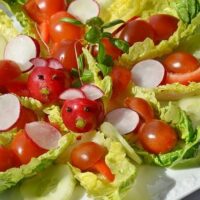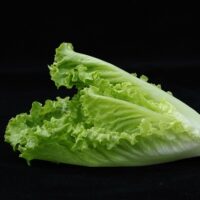For the Love of Leeks, and Hot Cakes
It’s the week of the leek. From the looks of the leek I have in my fridge, it’s a good thing that at week #38, baby is about to make his grand worldly entrance.
Pictured, is me holding a typical leek. Yes, it resembles a giant green onion. 
Leeks belong to the same family as onions, chives, scallions, garlic, and shallots.
They have a mild, somewhat sweet flavor, and acquire a creamy texture when cooked.
The first time I took notice of the leek, I was in San Francisco trying to dine at Postrio, a Wolfgang Puck restaurant. There was no way to get in for dinner, so we sat at the bar and ordered a leek and shrimp pizza.
It was AMAZING!
I immediately worked to recreate it when I returned to my kitchen. I came up with a Chèvre (goat cheese), Leek and Shrimp Pizza that was pretty tasty. That was about 30+ years ago. Postrio closed in 2009.
As luck would have it, I found a fairly simple “comfort food” leek recipe to share. I’m planning to make it Friday to accompany my fish.
Of course, leeks are very nutritious, extremely low in calories, and very versatile, like onions.
The greatest adventure in working with leeks is cleaning the mud out between the layers. This step is critical so that you don’t find dirt or grit in your dish.
To clean them, cut off the hair-like end and most of the tough green parts from the other end. Then slice them in half, from top to bottom. Fan out the layers and rinse under running water to remove any dirt or grit.
Another way I’ve done it is to cut off both ends as above, then chop so that I have rings of the leek, the same way I’d cut a green onion. I then separate those leek ringlets in a colander and rinse well.Choose whichever way is best for your recipe. 
There are many ways to use leeks: in tarts; potato and leek soup (a classic from Julia Child); sauté and top your pizza or burger; roast with other veggies; add to pasta; any way you’d use an onion.
Leek, Potato and Zucchini Hot Cakes
1 medium potato
2 cups sliced leeks (white and pale green parts only)
1 cup shredded zucchini
1/4 cup flour or gluten-free flour
1 egg, slightly beaten
1-2 tsp dried red chili flakes (according to your “heat” preference)
Salt and pepper
Oil for frying
Preheat your oven to 350 degrees F. Bake the potato until it’s tender enough to pierce through with a fork, about 40-45 minutes.
Boil a saucepan of salted water and add the sliced leeks and cook until tender, about 5 minutes. Drain and wrap in a tea towel; wring out any extra moisture. Set aside.
Drain the shredded zucchini of its moisture. Wrap in a tea towel and wring it as well. Set aside.
Once the potato is cooked, peel it and roughly mash it.
Mix all the ingredients together and season to taste.
Make patties from the mixture. Heat about 2 Tbsp. oil in a skillet. When hot, gently drop the patties into the oil (medium heat), flatten with a spatula and let cook until nicely browned on both sides. Remove and drain on paper towels. (Recipe derived from nodesserts blog)
Plain Greek yogurt or sour cream with dill makes a nice dipping sauce to accompany these.
Bon appétit!
Much love,
Carol
“Labor is the only blind date where you know you will meet the love of your life.”–babycenter









